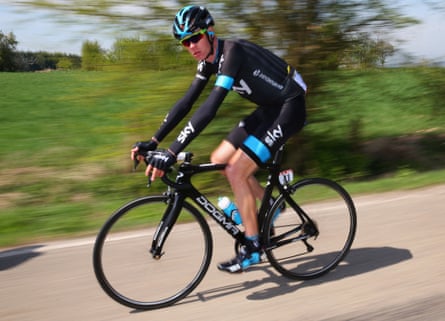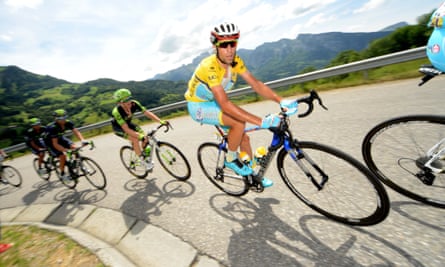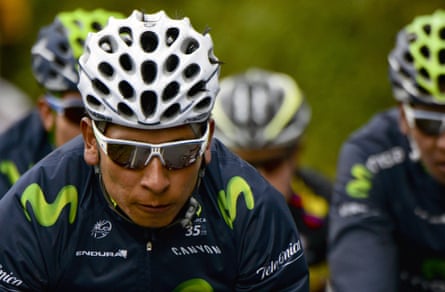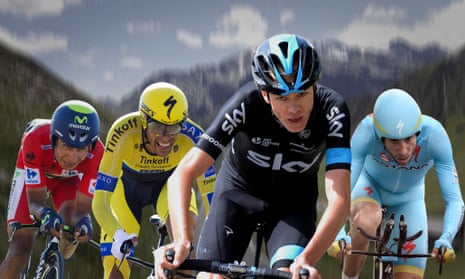In May the Tour de France picture muddies as the favourites disappear to the altitude training camps which are now all the rage but in the second half of June every pedal stroke in the brief series of Tour warm-up races takes on added significance. The 2015 Tour has a mouth-watering look about it because it should boast four lead candidates for victory – Chris Froome, Nairo Quintana, Vincenzo Nibali and Alberto Contador – none of whom looks to be head and shoulders above the others.
Assuming they all get through the opening phase of the Tour in one piece, any one of them can be viewed as a possible victor on diverse grounds such as youth, experience, climbing ability, team backing and race management. In addition there is a large subgroup of outsiders who, on paper at least, should be fighting for the podium.
With the Critérium du Libéré and Giro d’Italia out of the way, and other races such as the Tour de Suisse, Route du Sud and Ster ZLM Toer well under way, all the Tour names have broken cover but the great unknown remains in what shape they will all turn up at the Grand Départ in Utrecht on 4 July.

Alberto Contador
The 2007 and 2009 Tour winner briefly took a back seat after winning the Giro d’Italia in May, where he rode a calculating race – or perhaps laboured with a shoulder injury – to finish the three weeks without a single stage win, holding off a concerted challenge from the Astana squad largely by gauging just the right moments to expend his energy.
After a rest Contador followed the Giro with an altitude camp at Livigno in Switzerland – although he said he has managed only three days hard training due to fatigue – before returning to racing in the Route du Sud in southern France where he won Saturday’s key Pyrenean stage after pulling ahead of Nairo Quintana on the final descent. Of the quartet, he has the least to lose, having already landed a Grand Tour win this season, and this relaxed frame of mind could prove his great strength given the nerves that always mark the start of the Tour de France.

Chris Froome
As victory in the Dauphiné a week ago showed, the winner of 2013 Tour has returned to somewhere near his best after a spring that was disrupted by illness. If Froome is correct and he has a little further to progress between the Dauphiné and the Tour, then he will hit his best form by 4 July. That is critical, because at the Dauphiné, although the Kenyan-born Briton was the fastest over the eight days, he did not open the conclusive margins on the mountain climbs that he will need to forge at the Tour.
Critically his entire Sky team look to be coming to the boil as well, with Peter Kennaugh, Ian Stannard, Wout Poels, Geraint Thomas and Nicolas Roche all shining recently. Froome’s biggest loss of time at the Dauphiné came in the team time trial, a discipline where Sky will need to be at full strength next month.

Vincenzo Nibali
The defending champion is performing in a way uncannily similar to 12 months ago. As with last year, Nibali has focused his buildup on training rather than racing in May and early June, opting for a three-week block of altitude training in Tenerife, coincidentally at the same time and in the same hotel as Froome.
As with Froome, the Dauphiné was his pre-Tour test but, unlike the Sky leader, Nibali was clearly making efforts only on certain days – such as stage six through the Vercors, when he was in a day-long escape, and the final stage, when he put the hammer down to impressive effect early on the final climb.
On other stages at key moments he was observing his power meter and slipping off the pace in a way that indicated he was riding to the orders of his trainer not to dig too deep. This worked for him in 2014 and it might well do so again.

Nairo Quintana
The Colombian climbing sensation will start as favourite for the Tour because of the huge number of climbs packed into the finale, where four days up and down through the Alps culminate in a brief leg over the Col du Galibier – the highest pass regularly climbed by the race – to the classic finish at l’Alpe d’Huez.
Having won the Giro last year, and finished second to Froome in the 2013 race – on a route with a similar structure to this year’s – the 25-year-old looks ready to take the final step, the more so after having beaten Nibali and Contador to win Tirreno-Adriatico in March. As in previous years he has been absent from European racing for May and part of June, preferring to return to his home in Boyacá to make the best of training at altitude. Given his absence for so long, his return at the Route du Sud was eagerly awaited and he did not disappoint, matching Contador up the toughest climb on Saturday’s principal mountain stage, although he slipped behind the Spaniard on the descent to the finish.
Behind the Big Four is a jostling pack of potential candidates for the podium in Paris, who have begun to show their hands. Foremost among them is France’s Thibaut Pinot, third overall last year, who has stepped up this year with victories in the toughest mountain stages at the Tour de Romandie and Tour de Suisse.
Pinot was in the yellow jersey at the Swiss race going into its final weekend but was being pressed hard by Geraint Thomas, who is having a stellar season and looks ready to play a lead support role to Froome in France or step in if his leader falters.
Last year’s surprise runner-up Jean-Christophe Péraud won the Critérium International in March but on current form looks set to play second fiddle to his younger team-mate Romain Bardet, who finished sixth in the 2014 Tour and was an incisive winner of a mountain stage in the Dauphiné 10 days ago. The Dauphiné is traditionally the best pointer of form for the Tour and among those to hit the spotlight was the American Tejay van Garderen, who led the race before Froome took over and looks to be hitting his best climbing form.
Last year’s Dauphiné winner, Andrew Talansky, and his Cannondale-Garmin team-mate Daniel Martin were also in the mix in this year’s race. Not a Tour overall contender – yet – but one of that week’s surprises was the 22-year-old Simon Yates from Bury, who climbed with the best to finish fifth overall and will start the Tour in search of stage wins.
On which note, among the sprinters, Marcel Kittel continues to fight for fitness and is off the pace; André Greipel is performing consistently while Peter Sagan and Michael Matthews were the pick in the early stages in Switzerland where Mark Cavendish has yet to hit his best.
Bluffers’ guide to the Tour
■ The 102nd edition of the Tour de France starts outside France for the 21st time, with an individual time trial on Saturday 4 July in the Dutch city of Utrecht, birthplace of Marco van Basten and the Emmanuelle actress Sylvia Kristel, and location of the 1713 treaty that granted Gibraltar to Britain.
■ After the Grand Départ, the Tour then spends two days in Belgium before arriving in France on stage four.
■ The cobbles are back, despite last year’s precarious spells on the rain-lashed pavé. Organisers will be praying for more clement conditions on the 221km stage four between Seraing and Cambrai.
■ Stage three mirrors La Flèche Wallonne, with the same Mur de Huy climb to the finish as the classic.
■ The Tour’s 21 stages will cover a total distance of 3,360km and feature nine flat stages, three hill stages, seven mountain stages with five altitude finishes, one individual time trial, one team time trial and two rest days before arriving in Paris on Sunday 26 July.
■ Six cities are new to the Tour: Utrecht, Zélande, Livarot, La Pierre Saint-Martin, Muret and Sèvres.
■ La Pierre Saint-Martin will stage the initial summit finish.
■ The alpine finish at La Toussuire was where Chris Froome surged past Bradley Wiggins in 2012’s stage 11, sparking one of cycling’s great feuds – a bitter exchange on Twitter between Wiggins’ wife Cath and Froome’s then girlfriend (now wife) Michelle Cound.
■ The Tour will be broadcast live daily on ITV4, S4C and British Eurosport.

Comments (…)
Sign in or create your Guardian account to join the discussion